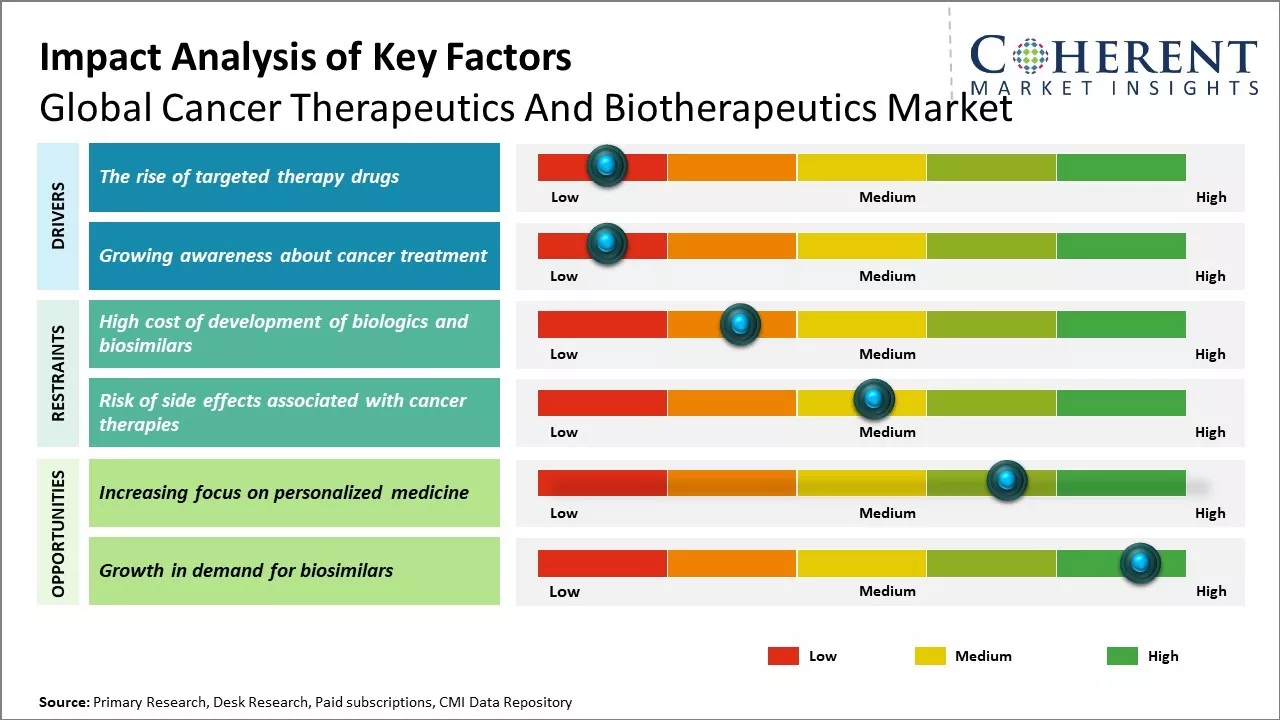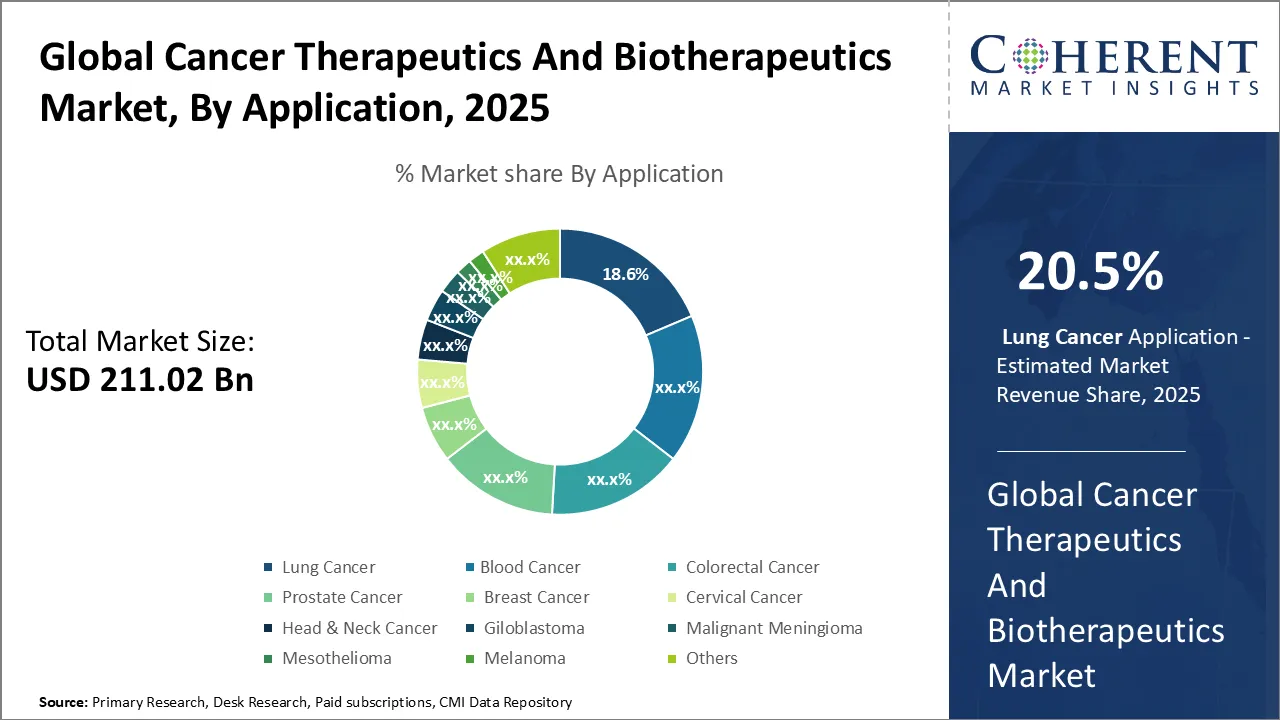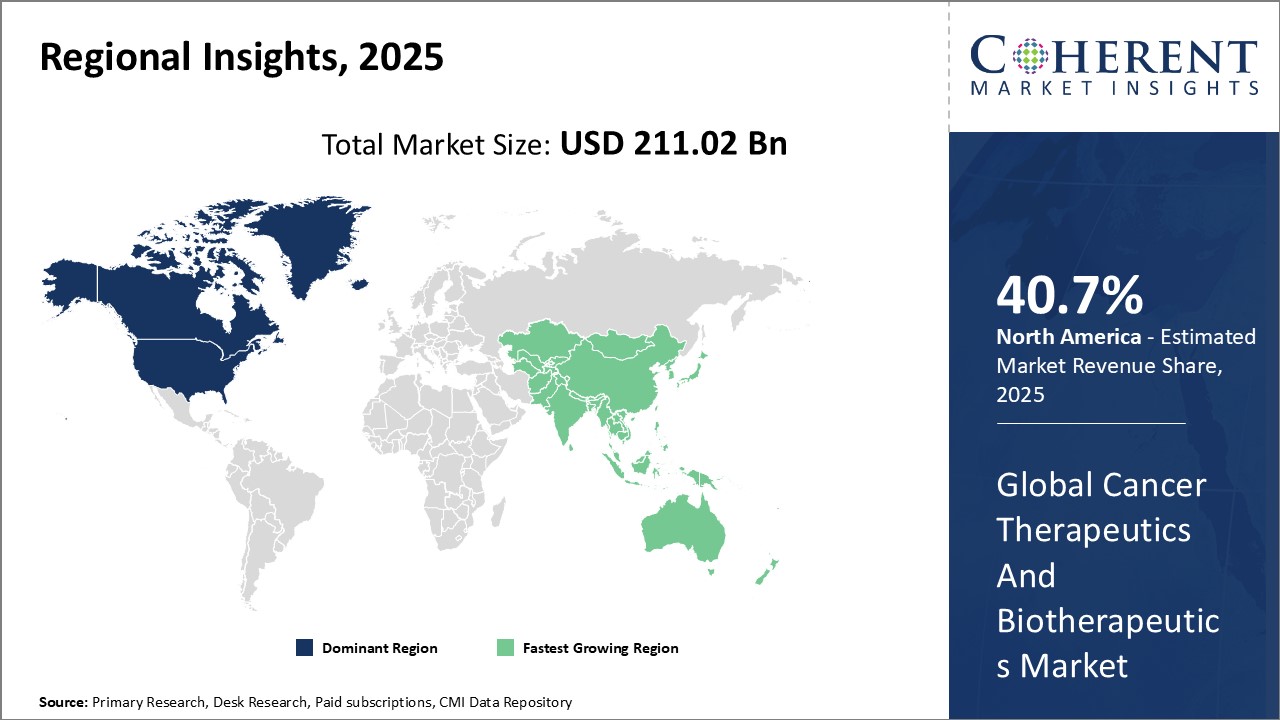Global Cancer Therapeutics And Biotherapeutics Market Size and Trends
The Global Cancer Therapeutics and Biotherapeutics Market is estimated to be valued at USD 211.02 Bn in 2025 and is expected to reach USD 378.62 Bn by 2032, exhibiting a compound annual growth rate (CAGR) of 8.7% from 2025 to 2032. The market has been witnessing steady growth over the past few years owing to the rising awareness about healthcare associated infections and increasing prevalence of chronic diseases.

Discover market dynamics shaping the industry: Download Free Sample
The cancer therapeutics and biotherapeutics market is expected to witness a steady growth over the forecast period owing to the increasing prevalence of cancer worldwide. The rising need for the treatment of various types of cancer including blood cancer, breast cancer, lung cancer, prostate cancer, and colorectal cancer is expected to drive the demand for cancer therapeutics and biotherapeutics. Additionally, growing preference for targeted therapy over conventional chemotherapy is further expected to support the growth of this market during the forecast period. Increasing government initiatives to spread awareness about cancer and improve the access to early screening and diagnosis is also projected to propel the cancer therapeutics and biotherapeutics market growth between 2025 and 2032.
The rise of targeted therapy drugs
One of the key drivers of growth in the global cancer therapeutics and biotherapeutics market has been the rise of targeted therapy drugs. Traditional chemotherapy drugs aimed to destroy cancer cells but often damaged healthy cells as well, leading to harmful side effects. In recent years, breakthroughs in cancer research have led to the development of targeted drugs that home in on specific molecular targets found on cancer cells. These molecular targets could be overexpressed proteins on the cancer cell surface, mutated proteins driving cell growth and survival or changes to genes and chromosomes. Examples include trastuzumab for HER2-positive breast cancer, imatinib for chronic myeloid leukemia, and vemurafenib for melanoma with BRAF mutations. Targeted drugs are more precise than traditional chemotherapy in distinguishing cancer cells from normal cells. As a result, they can be more effective at killing cancer cells while reducing damage to healthy cells. This translates to improved clinical outcomes for patients such as higher response rates, longer duration of response, and sometimes even cure. Targeted drugs also tend to have milder and more tolerable side effect profiles compared to chemotherapy. Their improved efficacy and safety profiles have led to rapid uptake by oncologists and patients. With advances in diagnostic testing, more cancer driver mutations and biomarkers are being discovered each year, further expanding the pool of patients eligible for targeted therapies. Drug companies have also made huge investments in developing new targeted agents, bringing multiple new pipeline drugs to market annually. All of these factors have combined to power strong growth in the targeted therapy segment.
Market Concentration and Competitive Landscape

Get actionable strategies to beat competition: Download Free Sample
Growing awareness about cancer treatment
Cancer awareness across the globe has seen significant rise in recent years. Various non-profit organizations and governments are running widespread educational campaigns about cancer prevention, early detection and treatment options. This has boosted patient awareness about new therapeutic and biological treatment methods available for cancers. As people are more informed about biochemical and immune-based therapies, their preferences are shifting away from conventional chemotherapy towards more targeted and personalized approaches. Companies are continuously developing novel biologics and cell and gene therapies providing more efficacious and less toxic alternatives to existing standards of care. The success of some of the first approved CAR T-cell and oncolytic virus therapies have also increased confidence in these newer areas. The improved understanding of cancer at molecular level has accelerated the drug development pipeline. There are currently over 2500 biologics and immunotherapies under clinical trials globally according to figures from American Society of Clinical Oncology released in 2021. This extensive R&D activity when successful in gaining regulatory approvals will lead to substantial increase in the product offerings in the market. As awareness increases and more effective therapies become available, the majority of patients are opting for biologic and cell/gene therapy combinations or sequential treatments rather than chemotherapy alone. This shift towards personalized precision medicines is expected to significantly drive the revenues for cancer therapeutics and biopharmaceutical companies in the coming years. The market is anticipated to witness high growth rates fueled by this expanding treatment landscape and burgeoning demand for advanced therapeutic solutions.
Key Takeaways from Analyst:
The increasing prevalence of cancer across both developed and developing nations will be a major driver. With growing awareness and early diagnosis rates, cancer treatment is advancing into personalized medicine using targeted therapies. Europe and North America currently dominate due to favorable reimbursement policies and advanced healthcare systems. However, Asia Pacific is expected to rise as the fastest growing region due to its massive population base and improving access to healthcare. Monoclonal antibody therapies have revolutionized cancer treatment and will continue gaining ground with ongoing innovations. Cell-based cancer immunotherapies have shown promise for solid tumors and their market potential is substantial.
Biosimilars are also opening up opportunities for more affordable targeted treatments over the coming years. However, high R&D costs for new drug development and clinical trials pose a restraint. Data security and patient privacy regulations differ internationally and add a layer of complexity. Reimbursement coverage and healthcare infrastructure disparities across regions also impact market accessibility. Going forward, collaborations between pharmaceutical companies and public research institutions may help accelerate the drug development process. Integration of digital technologies into cancer research and management also holds promise for improving patient outcomes.
Market Challenges: High cost of development of biologics and biosimilars
The development of biologics and biosimilars for cancer therapeutics requires huge investments due to the complex nature of bioengineering living organisms. Producing biologics involves extensive research and clinical trials spanning several years to develop specialized cell lines, optimize manufacturing processes and ensure product quality and safety. This level of R&D investment puts immense financial pressure on biopharma companies. For a single biologic, the estimated cost of development including failures is as high as US$ 2-3 billion. Given these exorbitant costs and long gestation periods of 8-12 years for a new biologic to reach the market, smaller companies and startups find it extremely difficult to raise such capital.
The high capital investment deters many companies from venturing into areas like personalized medicines and combination therapies where development costs are further amplified. For biosimilars as well, the costs remain high at US$ 100-250 million owing to requirements of elaborate clinical end-point and pharmacovigilance studies. The price sensitive nature of cancer care in most countries poses reimbursement challenges for expensive drugs. Due to the COVID-19 pandemic, the global economy slowed down significantly affecting investments in healthcare R&D. As per World Bank data, the world GDP declined by 3.5% in 2020, the worst recession in decades impacting investments across sectors. These financial barriers collectively restrain aggressive research into novel targets and new drug classes. While large pharmas have the financing abilities and risk appetite, they also play it safe by prioritizing cheaper generic and biosimilar versions over high-risk innovation.
Market Opportunities: Increasing focus on personalized medicine
The rise of personalized medicine is presenting a huge opportunity for growth in the global cancer therapeutics and biotherapeutics market. Personalized medicine considers individual variability in genes, environment, and lifestyle for each person. It allows doctors and researchers to predict more accurately which prevention and treatment strategies will work best. With advancements in precision oncology and advancement of targeted therapies, more and more cancer treatments are becoming personalized. Researchers and pharmaceutical companies are developing targeted drugs that one can personalize for each person's specific type of cancer and genetic makeup. This enables them to identify which patients are most likely to benefit and experience durable responses from particular treatments. Several targeted therapies now focus on specific genetic mutations or proteins expressed by tumor cells. For example, treatments such as Herceptin target breast cancers that overexpress the HER2 gene. This shift towards personalized cancer care is proving much more effective than traditional one-size-fits-all treatments. It minimizes adverse effects by avoiding drugs that won't impact an individual's cancer. This improves clinical outcomes and quality of life for patients. The approach paves the way for faster drug approval processes by enriching clinical trials for candidates most likely to respond. According to a WHO study published in 2022, there has been a 47% rise in new cancer drug approvals globally between 2018 and 2021 compared to the previous four years, largely driven by an increase in immunotherapies and targeted therapies.

Discover high revenue pocket segments and roadmap to it: Download Free Sample
By Application - Lung cancer: Growing prevalence and risk factors drive segment growth
In terms of Application, the Lung Cancer segment is estimated to hold the highest market share of 20.5% in 2025 owing to its high prevalence worldwide. Lung cancer has the highest mortality rate of all cancers as it often goes undetected until late stages. The key risk factors such as cigarette smoking, outdoor and indoor air pollution, radon exposure, occupational exposures to certain gases and chemicals puts large population at risk. As per reports, around 1.80 million new cases of lung cancer are diagnosed annually worldwide. With growing environmental pollution levels and continued tobacco usage, the incidence of lung cancer is expected to further increase in the coming years. This will significantly drive the demand for advanced therapeutics and biotherapeutics for lung cancer treatment.
By Therapy Type - Chemotherapy: Established benefits yet evolving needs drive segment growth
In terms of Therapy Type, the Chemotherapy segment is estimated to hold the highest market share of 25.5% in 2025 due to its wide acceptance and established benefits for management of various cancers. However, the segment is witnessing significant changes with the advent of targeted therapies and immunotherapies. While chemotherapy drugs exert cytotoxic effects on fast-dividing cancer cells, they often lack specificity and cause damaging side effects. This has led to the development of more precise targeted therapies. At the same time, the need for overcoming resistance and improving patient outcomes is driving combination therapies using chemotherapy with other treatment modalities. The segment is also expanding its pipeline with newer chemotherapy drugs and formulations to sustain its leading position.
By End User - Hospitals & Clinics: Infrastructure and expertise driving segment share
In terms of End User, the Hospitals & Clinics segment is estimated to hold the highest market share of 40.5% in 2025 owing to well-developed health infrastructure for cancer care in major markets. Hospitals are suitably equipped with modern diagnostic and treatment facilities along with a pool of specialized oncologists, surgeons, and other staff. They also offer a wide range of therapies under one roof along with in-patient and post-treatment care. This integrated delivery model and focus on quality of care makes hospitals the preferred treatment setting. Furthermore, multitude of hospitals networks and cancer care centers worldwide are expanding their infrastructure and services to meet the growing needs of cancer patients. These factors will continue to attract more patients and sustain the leadership of this segment.
Regional Insights

Need a Different Region or Segment? Download Free Sample
North America has established itself as the dominant region with an estimated share of 40.7% in 2025 in the global cancer therapeutics and biotherapeutics market. With major pharmaceutical companies from the U.S. and Canada having sizable R&D budgets to invest in developing novel targeted therapies and immunotherapies, the region accounts for the highest number of late-stage clinical trials. Additionally, supportive regulatory guidelines by the FDA and Health Canada have ensured faster approval times for innovative treatment options. This allows patients in the U.S. and Canada early access to life-saving drugs compared to other regions.
The presence of top cancer centers and skilled oncologists has also ensured higher adoption rates of high-cost specialty therapies. Most private and public health insurance plans offer significant coverage for FDA-approved therapies, albeit with patient co-pays. This, coupled with growing healthcare expenditures, contributes to North America being the most lucrative market globally. Leading pharma companies prioritize drug launches and marketing initiatives targeting the region to gain maximum returns on investment. The Asia Pacific region has emerged as the fastest growing market for cancer therapeutics and biotherapeutics. Expanding healthcare infrastructure across major Asian countries like China, Japan, South Korea, India, and Australia provide tailwinds for market growth. Governments are increasingly focusing on enhancing access to cancer care with supportive regulatory and funding policies. This has improved the availability of both generic and patented drugs over the past decade.
Furthermore, the increasing incidence of cancer due to lifestyle changes, growing disposable incomes, and demand for advanced treatment options from both private healthcare providers and patients are driving the APAC market. While out-of-pocket costs remain relatively higher compared to developed markets, several pharma companies have introduced more affordable biosimilars and targeted therapies to tap into the vast commercial opportunities offered. With healthcare projected to become one of the top sectors for investments, the APAC region is anticipated to witness double-digit growth rates in the coming years.
Market Report Scope
Global Cancer Therapeutics And Biotherapeutics Market Report Coverage
| Report Coverage | Details | ||
|---|---|---|---|
| Base Year: | 2024 | Market Size in 2025: | USD 211.02 Bn |
| Historical Data for: | 2020 To 2024 | Forecast Period: | 2025 To 2032 |
| Forecast Period 2025 to 2032 CAGR: | 8.7% | 2032 Value Projection: | USD 378.62 Bn |
| Geographies covered: |
|
||
| Segments covered: |
|
||
| Companies covered: |
Amgen Inc., Bristol-Myers Squibb, Celgene Corporation, ELI Lilly and Company, Hoffmann-La Roche AG, EnGeneIC Ltd, Merck & Co Inc., Novartis, Pfizer Inc., Johnson & Johnson, AstraZeneca, Bristol-Myers Squibb, Biogen IDEC, Sanofi, Novartis AG, Roche, Schering-Plough, Gilead Sciences, and Takeda Pharmaceutical Company |
||
| Growth Drivers: |
|
||
| Restraints & Challenges: |
|
||
Uncover macros and micros vetted on 75+ parameters: Get instant access to report
Market Segmentation
- Application Insights (Revenue, USD Bn, 2020 - 2032)
- Blood Cancer
- Lung Cancer
- Colorectal Cancer
- Prostate Cancer
- Breast Cancer
- Cervical Cancer
- Head and Neck Cancer
- Giloblastoma
- Malignant Meningioma
- Mesothelioma
- Melanoma
- Others
- Therapy Type Insights (Revenue, USD Bn, 2020 - 2032)
- Chemotherapy
- Targeted Therapy
- Immunotherapy
- Radiation Therapy
- Hormone Therapy
- Biotherapy
- Others
- Application Insights (Revenue, USD Bn, 2020 - 2032)
- Therapeutics
- Drug Discovery
- Gene therapy
- IVF treatment
- Cell therapy
- Research & Development
- End user Insights (Revenue, USD Bn, 2020 - 2032)
- Hospitals & Clinics
- Cancer Care Centers
- Research Institutes
- Others
- Regional Insights (Revenue, USD Bn, 2020 - 2032)
- North America
- U.S.
- Canada
- Latin America
- Brazil
- Argentina
- Mexico
- Rest of Latin America
- Europe
- Germany
- U.K.
- Spain
- France
- Italy
- Russia
- Rest of Europe
- Asia Pacific
- China
- Indi
- Japan
- Australia
- South Korea
- ASEAN
- Rest of Asia Pacific
- Middle East
- GCC Countries
- Israel
- Rest of Middle East
- Africa
- South Africa
- North Africa
- Central Africa
- North America
- Key Players Insights
- Amgen Inc.
- Bristol-Myers Squibb
- Celgene Corporation
- ELI Lilly and Company
- Hoffmann-La Roche AG
- EnGeneIC Ltd
- Merck & Co Inc.
- Novartis
- Pfizer Inc.
- Johnson & Johnson
- AstraZeneca
- Bristol-Myers Squibb
- Biogen IDEC
- Sanofi
- Novartis AG
- Roche
- Schering-Plough
- Gilead Sciences
- Takeda Pharmaceutical Company
Share
Share
About Author
Nikhilesh Ravindra Patel is a Senior Consultant with over 8 years of consulting experience. He excels in market estimations, market insights, and identifying trends and opportunities. His deep understanding of the market dynamics and ability to pinpoint growth areas make him an invaluable asset in guiding clients toward informed business decisions. He plays a instrumental role in providing market intelligence, business intelligence, and competitive intelligence services through the reports.
Missing comfort of reading report in your local language? Find your preferred language :
Transform your Strategy with Exclusive Trending Reports :
Frequently Asked Questions
EXISTING CLIENTELE
Joining thousands of companies around the world committed to making the Excellent Business Solutions.
View All Our Clients
